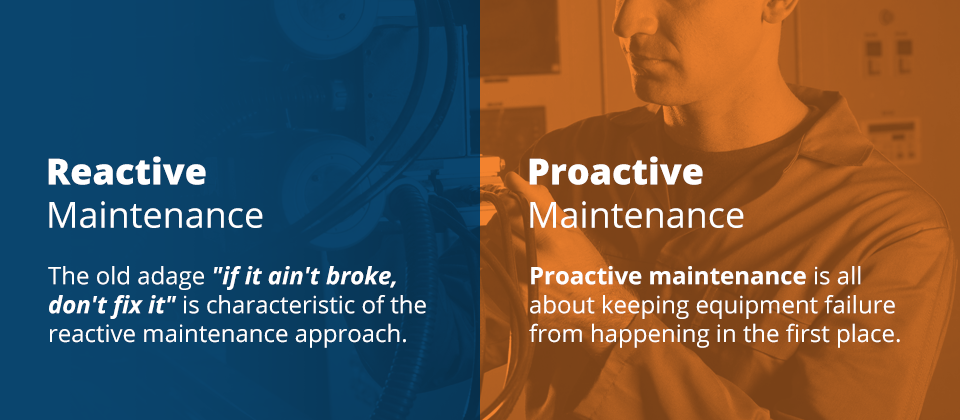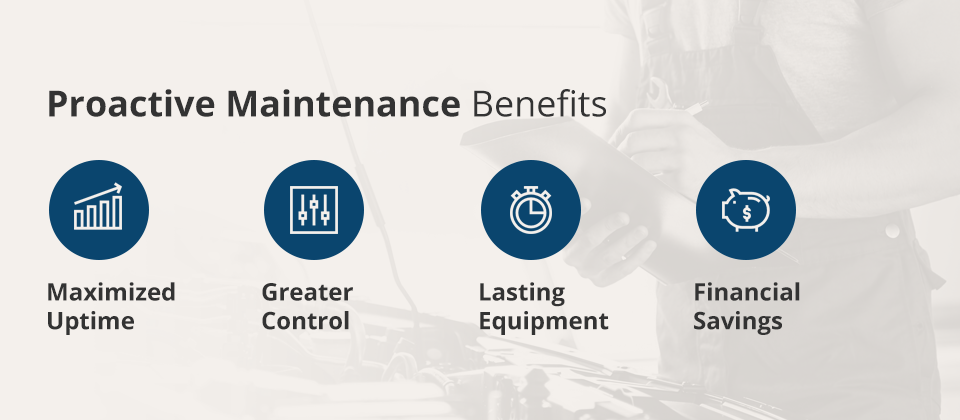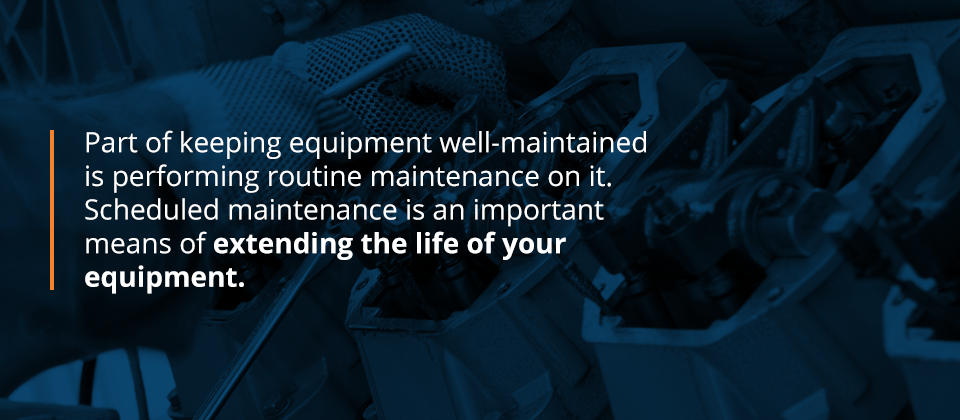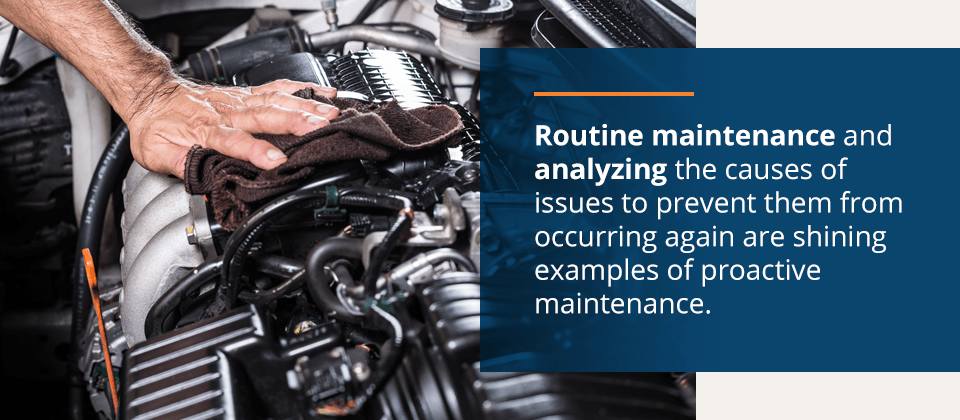Imagine this: A piece of machinery that is at the heart of your business’s operations has unexpectedly just broken down. Some companies may react simply by trying to repair or replace the equipment as quickly as possible. Inevitably, though, it will take some time. Meanwhile, your operations have come to a screeching halt.
Fixing the problem is important, but it doesn’t get at the heart of the problem. Instead of just trying to fix the broken equipment, it’s time to ask yourself some questions. What caused the breakdown? Is there anything you could have done to prevent it? How will you keep it from happening again? If you ask yourself these questions, then you’re well on your way to a better approach to maintenance, one that does not simply react but strategically plans ahead.
In this post, we’ll discuss the concept of proactive maintenance — what it is, why it’s valuable and how to implement it. Keep reading to find out how your company can benefit from this strategic approach to maintenance.
Proactive Maintenance: What Is It?
Before we discuss the value of proactive maintenance, let’s take some time to explain the concept. First, the idea of maintenance, in general, is based on the reality that machinery and technology fail. No matter how well-made or high-quality your electronics, motors or other types of equipment are, they are subject to wear and tear. Maintenance involves checking, servicing, repairing or replacing parts that need it to keep operations functioning as they should.
No matter what type of equipment your business uses for its operations, there is no doubt that this equipment needs to be maintained. Some companies choose to conduct their maintenance in-house, while others call in outside experts to work on their equipment. However they get it done, maintenance is crucial to a business’s operations — particularly if that business is in manufacturing. Though all companies must maintain their equipment, the approach they take to maintenance may differ.
As mentioned above, one way in which they can differ is whether they conduct their own maintenance or have their equipment serviced and repaired by an outside source. A more significant distinction, however, can be found in which of two major approaches to maintenance they take: reactive or proactive. These two approaches stand in stark contrast to one another.

Let’s take a look at reactive vs. proactive maintenance to see how they differ:
- Reactive Maintenance: The old adage “if it ain’t broke, don’t fix it” is characteristic of the reactive maintenance approach. Also called corrective maintenance, reactive maintenance means waiting until a problem occurs and then responding to it by repairing or replacing the piece of equipment that failed. This approach often involves unplanned downtime since you’re caught off guard by the problem and, therefore, aren’t prepared to keep operations running efficiently while the maintenance is taking place. Of course, downtime can cost your business significantly.
- Proactive Maintenance: Proactive maintenance is all about keeping equipment failure from happening in the first place. This involves performing inspections, tests and maintenance activities to make sure equipment is functioning ideally and that no underlying problems could cause a failure. If a breakdown does occur, the proactive approach places a high priority on finding the root cause in order to prevent it from causing problems in the future. Keeping an eye on equipment and properly maintaining it gives you a greater degree of control over the situation and can save you time, effort and money.
As we will see, proactive maintenance is the better approach of the two. Of course, you can’t predict and prevent every problem. Sometimes, emergency maintenance issues occur and necessitate reactive maintenance. However, most problems can be avoided through proactive maintenance. Maintenance programs for top-performing organizations are typically less than 10 percent reactive.
Being proactive requires a more deliberate and strategic plan, which may seem to need more work upfront, but it can also be of great benefit to your business, both in the short- and long-term.
Why Is Proactive Maintenance Valuable?
Many professionals recognize that, while proactive maintenance requires more planning and effort upfront, it is a superior approach to take. In fact, a survey involving lubrication professionals found that 95 percent of them see proactive maintenance as an investment. An investment is something that may cost you up front but will benefit you in the long run, and this is exactly how proactive maintenance works.
Engaging in proactive maintenance means you’re thinking long-term and making an investment that may cost you now but help you tremendously later. So, how does proactive maintenance help? Why is it so valuable? Proactive machinery maintenance or proactive electronic maintenance is valuable both for what it helps you avoid and, in turn, what you can gain from it. Let’s look first at what proactive maintenance can help your company avoid:
- Unplanned Downtime: Downtime is the enemy of efficiency and profits. If a machine that is crucial to your operations breaks down unexpectedly, then everything can come to a halt at worst and slow down at best. Every hour and day your operations are either on pause or even functioning at limited capacity can mean a serious cost to your productivity and bottom line.
- Replacement Costs: When something is worn down until it breaks or fails altogether, repairing it no longer becomes an option. Instead, you must replace the piece of equipment. In some cases, one piece of equipment failing in a larger piece of machinery can cause a ripple effect of damage. When something breaks, it can take significant amounts of time and effort to fix and may also come with a significant financial cost, more significant than repairs or preventive maintenance measures.
- Repeat Problems: Sometimes, fluke failures occur, but more often, there’s a reason for the failure. If you don’t pay attention to the cause of an issue, then you’re vulnerable to experiencing that same issue again in the future. For example, if you’re running a piece of machinery in a way that causes too much wear and tear, you want to keep from doing that in the future. If you’re buying replacement parts from a manufacturer that are unreliable, you want to find better quality parts elsewhere.

In addition to helping you avoid these problems, proactive maintenance can deliver some important benefits, as well. The benefits you gain include:
- Maximized Uptime: Just as no one wants to experience unplanned downtime, everyone wants to maximize uptime. Uptime means operations are in full swing, working just as they should, without any problems putting them on pause or slowing them down. When equipment is well-maintained, it stays in use and allows you to keep productivity and profits high.
- Greater Control: Staying on top of maintenance is an important part of staying on top of business, in general. When you just passively let problems happen and then respond, that’s reactionary. It means the situation is controlling you when, instead, you should be controlling the situation. When you have greater control, you can plan for maintenance instead of letting unplanned maintenance hijack your schedule.
- Lasting Equipment: When equipment is properly cared for, you can expect it to last longer. We have all seen this principle played out in the daily objects we own. For instance, you maintain your car by getting the oil changed, rotating and replacing tires, doing diagnostics and having repairs done when necessary. These maintenance measures keep your car running for as long as possible. Maximizing the lifespan of a piece of machinery or technology is a wise means of saving money and preventing waste.
- Financial Savings: We’ve referenced a few ways proactive maintenance can save your company money and, therefore, increase your profits, but the savings may be more dramatic than you realize. Did you know that proactive maintenance can reduce your company’s maintenance bills by up to 70 percent? The financial savings you can enjoy from proactive maintenance is no small thing — it can make a real difference in your bottom line.
Proactive Maintenance Strategies
To take advantage of the many benefits of proactive maintenance, your company needs to put some strategies in place to transition from reactive maintenance to proactive. These strategies should be focused on generating buy-in and then on practical planning since proactive maintenance is first a mindset a company must adopt and then a practical method it must employ.
Here are four ideas to get your company started.
1. Convince Leadership and Employees of the Value of Proactive Maintenance
The first step before your company will devote the necessary time, budget and attention to proactive maintenance is to make sure the company’s leadership is behind the initiative and employees are on board. It helps to have a single person or small team leading the way in this initiative to generate buy-in across the company.
To convince the company of the value of proactive maintenance, communicate how it would have a positive effect on your operations specifically. Use a machine or set of machines that have experienced a pattern of maintenance issues as an example of an area that could use some improvement. Better yet, implement proactive maintenance with one of these machines and then gather data on the improvements you see and communicate that data to others.
Ensuring that you have buy-in across the company is key to making sure proactive maintenance is prioritized as it should and is carried out effectively.
2. Train a Maintenance Team to Inspect and Monitor Equipment
Once your company is committed to maintaining equipment proactively, it’s important to put together a team to perform routine inspections and to continually monitor equipment. Inspections and monitoring are important for catching maintenance issues early to address them proactively.
The team that is assembled should consist of engineers and technicians who are familiar with the equipment and are dedicated to the new initiative. This team should be able to not only conduct inspections and keep an eye on equipment but also capable of understanding failure modes and conducting failure and root cause analysis.

3. Schedule Routine Maintenance
Part of keeping equipment well-maintained is performing routine maintenance on it. Scheduled maintenance is an important means of extending the life of your equipment.
Schedule maintenance for each machine based on the manufacturer’s recommendations. Don’t rely on a one-size-fits-all plan. Every piece of equipment is different and experiences wear and tear in different ways. You can conduct maintenance in-house if your company has employees who are qualified to do so. However, there are some real advantages to outsourcing your machine maintenance.
4. Analyze Root Causes of Failures and Prevent Future Failures
When failures occur, it’s important that your in-house maintenance team or outside experts look into the root cause or causes of the failure. Finding the source of machinery or equipment failure is known as Root Cause Analysis (RCA). Knowing the cause can help to prevent the same issue from occurring again in the future.
Another type of analysis you should eventually incorporate into your proactive maintenance plan is Failure Modes and Effects Analysis (FMEA), which helps to reveal potential maintenance issues before they arise. Seeing problems on the horizon and preventing them is also commonly referred to as predictive maintenance.
There’s only so much you can predict just by manually monitoring machines. The Internet of Things has already had a profound effect on manufacturing, and one of the advantages it offers for maintenance is analytics programs that use big data and active monitoring to help predict maintenance issues before they occur.
Proactive Maintenance Examples
We’ve talked a lot about what proactive maintenance is, but sometimes it can be hard to get a firm grasp on what proactive maintenance really looks like until you have some solid examples of what it looks like in action. What proactive maintenance looks like for your company will depend on the maintenance needs of your machinery, but most machinery requires similar attention and care to stay up and running for a long time.

Some of the strategies discussed above are great examples of proactive maintenance for machinery. For example, routine maintenance and analyzing the causes of issues to prevent them from occurring again are shining examples of proactive maintenance. Here are some more specific examples:
- Keeping machines well-lubricated
- Testing machinery to detect erosion or surface material thinning
- Clean machinery regularly
Start Your Proactive Approach to Maintenance and See Great Results
Hopefully, the information in this post has helped you understand what proactive maintenance is and why it’s so important for your company. While reactive maintenance may feel easier in the moment, it is a drain on time and resources and results in further problems. In contrast, proactive maintenance requires more upfront planning and strategy but results in a great return on that investment. You can expect to enjoy several important benefits, including maximized uptime, a greater degree of control, equipment that’s more reliable and lasts longer and substantial financial savings.
If you want to learn more tips and best practices for effective maintenance, subscribe to our blog on the sidebar. If you’re interested in learning more about our maintenance services, contact us online or call us at 877-249-1701. We can not only offer expert services and repairs but consulting, as well. We want to help your company maximize its efficiency through proactive maintenance.

